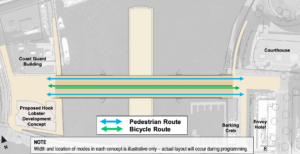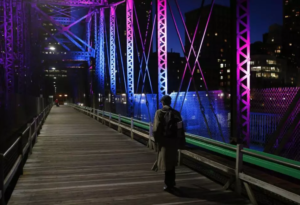A Car-Free Northern Ave. Bridge is Within Reach
The City of Boston is planning to rebuild the Northern Avenue Bridge to support rampant growth in the Seaport — and one proposed redesign would create a car-free haven for pedestrians and cyclists.
Join us in urging the city to build a bridge to a sustainable future, not a car-choked past.
 One of four concepts for updating and reopening the Northern Ave. Bridge.
One of four concepts for updating and reopening the Northern Ave. Bridge.On Wednesday, the city will present four design concepts for the bridge. The design above would limit access to pedestrians, cyclists and emergency vehicles. Another would add a high-occupancy vehicle (HOV) lane for transit, shuttles, carpools and ride shares, like Uber, carrying at least 3 people. The final two options would add cars to the mix, either in both directions or only westbound (exiting Seaport.)
We’re pleased that each concept features some form of separated bike and pedestrian facilities, which are sorely lacking in the area. That said, we strongly favor the design that prohibits vehicles entirely. Before being closed in 2014 due to deteriorating conditions, the Northern Avenue Bridge was already limited to people biking and walking — cars were banned in 1997. Why bring them back when there are three parallel roadways for motor vehicles? Imagine the bridge becoming a linear park with sidewalk cafes, absent of traffic noise.

In concept, the HOV design encourages more people to take transit, especially the commuter line. Yet the HOV lane may primarily benefit private shuttles while having only a marginal impact on public transit. (More info on that here.) We are also concerned about the ability to regulate ride sharing vehicles and the inevitability of a space shared with cars becoming car-centric. And the analysis doesn’t consider alternative — and more impactful — options for improving the Seaport’s woeful mass transit situation, like adding priority bus lanes on existing corridors in the area.
This project is a unique opportunity to not only build a safe, dedicated route for cyclists, but also to create a landmark destination with cultural and community space in a bustling neighborhood. Tell Boston to prioritize people and placemaking above motor vehicle traffic. Show up, and speak up!
For more information on the Northern Ave. Bridge project, head here.
